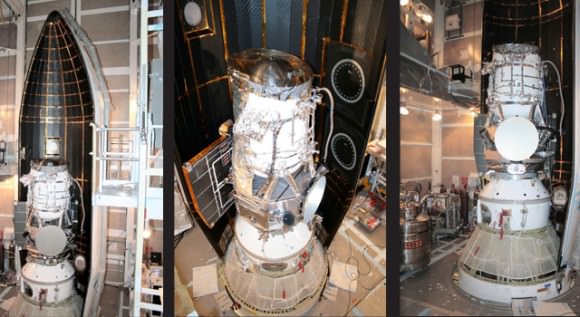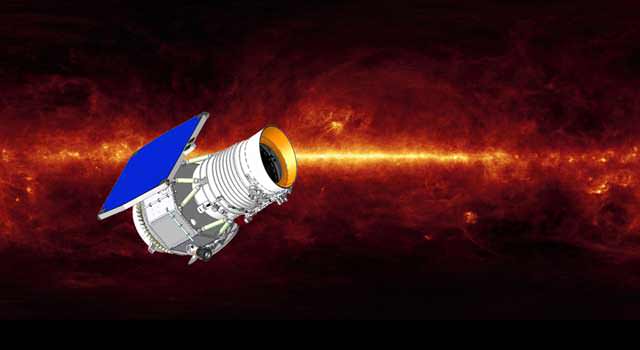NASA is getting WISE to the Universe this Friday. That is, they’re launching the Wide-field Infrared Survey Explorer, a new infrared space telescope that will survey objects in our Solar System and beyond, looking for asteroids and brown dwarfs close to home, and protoplanetary disks and newborn stars far off.
The WISE mission is another in a series of all-sky surveys that have become so very effective for research. The satellite will spend six months mapping the entire sky in the infrared, after which it will make a second, three-month pass to further refine the mapping. Rather than looking at any specific objects, the satellite will survey everything it can see with its infrared eyes, providing a detailed catalog of infrared-emitting objects for followup with telescopes like the Spitzer Space Telescope, the Herschel Space Observatory and the upcoming James Webb Space Telescope.
Infrared instruments detect heat, so the instrument must be cooled to a chilly 17 Kelvin (-265 degrees Celsius/ -445 degrees Fahrenheit). Otherwise, it would detect its own heat signature. This is accomplished by packing it in a cryostat, which is basically a large thermos filled with solid hydrogen. The cryostat is expected to keep the instrument cool enough for about 10 months of observation after the launch.
WISE is all ready to go, with the chilled instrument stowed safely in the nosecone that will fit atop a Delta II rocket. WISE will launch from Vandenberg Air Force Base in California on Friday, Dec. 11, between 9:09 a.m. and 9:23 a.m. EST. NASA will have live coverage of the launch available on NASA TV.

Objects that the WISE telescope will pick up include asteroids in our own Solar System that remain undetected because they are invisible in visible light. By doing an all-sky survey, WISE is expected to see hundreds of thousands of asteroids in our Solar System that haven’t been discovered, hundreds of them lying in the path of the Earth’s orbit. By cataloging these Earth orbit-crossing objects, astronomers can get a better idea of what threats from asteroid impact are lurking in the dark.
WISE will also be sensitive enough to pick up brown dwarfs, objects that straddle the line between planet and star. Though they are massive, they don’t quite make the cut for igniting nuclear fusion in their cores, but are warm enough to emit infrared light. It’s thought that there are quite a few of these objects in our own back yard waiting to be discovered, and WISE may double or triple the amount of star-like objects that are within 25 light-years of the Earth.
In addition to these smaller, closer finds, WISE will be able to see ultra-luminous infrared galaxies out in the distant regions of the Universe. These galaxies are bright in the infrared, but are invisible to telescopes that can only see in the visible light spectrum. The catalog may be a boon to extrasolar planet hunters, as the protoplanetary disks from which these planets form will be another object visible to the instrument.
The WISE telescope will have polar orbit with an altitude of 525 km (326 miles), and will circle the Earth 15 times each day. Snapshots of the sky will be taken every eleven seconds, allowing the instrument to image each position on the sky in the telescope’s field of view a minimum of eight times.
Be sure to check back with us for further coverage of the WISE launch on Friday!
Source: NASA press release, WISE mission site


Glad to see a better ‘asteroid hunter’ being put into orbit, a good step toward protecting our existence. On another note for the writer of this article, love the way you’re breaking up the paragraphs and using multiple units of measure. Makes for much easier reading.
WISE was originally scheduled for launch on Wednesday Dec. 9th. What pushed the date to Friday?
This gets my thumbs up. This is real science.
LC
I’ve got a bad feeling that the James Webb Space Telescope. will be a disaster.
One minor glitch and it “Goodnight Irene”, and no one can go and fix it.
(Let’s hope the mirrors are figured properly, unlike Hubble!)
So a brown dwarf near us, such as Nibiru or Planet X is supposed to be, could not play hide and seek any more :-))
BTW: Why can’t I log out from UT but repeatedly get a message:
“You are attempting to log out of Universe Today
Please try again.”
I do loves me some all-sky surveys. I don’t know what it is about that big ellipse.